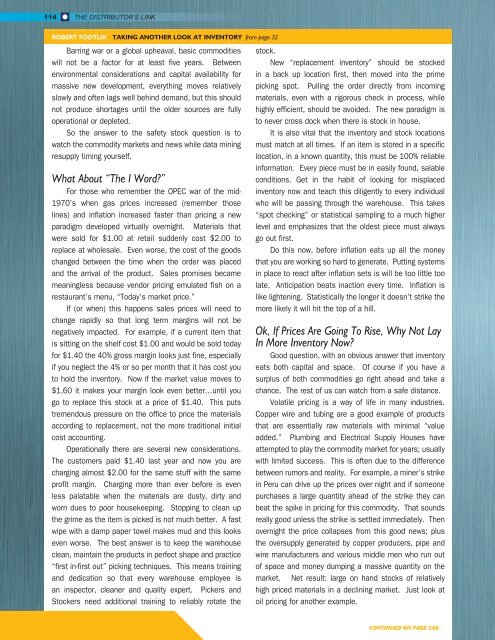SUMMER 2016
Distributor's Link Magazine Summer Issue 2016 / Vol 39 No3
Distributor's Link Magazine Summer Issue 2016 / Vol 39 No3
Create successful ePaper yourself
Turn your PDF publications into a flip-book with our unique Google optimized e-Paper software.
114<br />
THE DISTRIBUTOR’S LINK<br />
ROBERT FOOTLIK TAKING ANOTHER LOOK AT INVENTORY from page 32<br />
Barring war or a global upheaval, basic commodities<br />
will not be a factor for at least five years. Between<br />
environmental considerations and capital availability for<br />
massive new development, everything moves relatively<br />
slowly and often lags well behind demand, but this should<br />
not produce shortages until the older sources are fully<br />
operational or depleted.<br />
So the answer to the safety stock question is to<br />
watch the commodity markets and news while data mining<br />
resupply timing yourself.<br />
What About “The I Word?”<br />
For those who remember the OPEC war of the mid-<br />
1970’s when gas prices increased (remember those<br />
lines) and inflation increased faster than pricing a new<br />
paradigm developed virtually overnight. Materials that<br />
were sold for $1.00 at retail suddenly cost $2.00 to<br />
replace at wholesale. Even worse, the cost of the goods<br />
changed between the time when the order was placed<br />
and the arrival of the product. Sales promises became<br />
meaningless because vendor pricing emulated fish on a<br />
restaurant’s menu, “Today’s market price.”<br />
If (or when) this happens sales prices will need to<br />
change rapidly so that long term margins will not be<br />
negatively impacted. For example, if a current item that<br />
is sitting on the shelf cost $1.00 and would be sold today<br />
for $1.40 the 40% gross margin looks just fine, especially<br />
if you neglect the 4% or so per month that it has cost you<br />
to hold the inventory. Now if the market value moves to<br />
$1.60 it makes your margin look even better…until you<br />
go to replace this stock at a price of $1.40. This puts<br />
tremendous pressure on the office to price the materials<br />
according to replacement, not the more traditional initial<br />
cost accounting.<br />
Operationally there are several new considerations.<br />
The customers paid $1.40 last year and now you are<br />
charging almost $2.00 for the same stuff with the same<br />
profit margin. Charging more than ever before is even<br />
less palatable when the materials are dusty, dirty and<br />
worn dues to poor housekeeping. Stopping to clean up<br />
the grime as the item is picked is not much better. A fast<br />
wipe with a damp paper towel makes mud and this looks<br />
even worse. The best answer is to keep the warehouse<br />
clean, maintain the products in perfect shape and practice<br />
“first in-first out” picking techniques. This means training<br />
and dedication so that every warehouse employee is<br />
an inspector, cleaner and quality expert. Pickers and<br />
Stockers need additional training to reliably rotate the<br />
stock.<br />
New “replacement inventory” should be stocked<br />
in a back up location first, then moved into the prime<br />
picking spot. Pulling the order directly from incoming<br />
materials, even with a rigorous check in process, while<br />
highly efficient, should be avoided. The new paradigm is<br />
to never cross dock when there is stock in house.<br />
It is also vital that the inventory and stock locations<br />
must match at all times. If an item is stored in a specific<br />
location, in a known quantity, this must be 100% reliable<br />
information. Every piece must be in easily found, salable<br />
conditions. Get in the habit of looking for misplaced<br />
inventory now and teach this diligently to every individual<br />
who will be passing through the warehouse. This takes<br />
“spot checking” or statistical sampling to a much higher<br />
level and emphasizes that the oldest piece must always<br />
go out first.<br />
Do this now, before inflation eats up all the money<br />
that you are working so hard to generate. Putting systems<br />
in place to react after inflation sets is will be too little too<br />
late. Anticipation beats inaction every time. Inflation is<br />
like lightening. Statistically the longer it doesn’t strike the<br />
more likely it will hit the top of a hill.<br />
Ok, If Prices Are Going To Rise, Why Not Lay<br />
In More Inventory Now?<br />
Good question, with an obvious answer that inventory<br />
eats both capital and space. Of course if you have a<br />
surplus of both commodities go right ahead and take a<br />
chance. The rest of us can watch from a safe distance.<br />
Volatile pricing is a way of life in many industries.<br />
Copper wire and tubing are a good example of products<br />
that are essentially raw materials with minimal “value<br />
added.” Plumbing and Electrical Supply Houses have<br />
attempted to play the commodity market for years; usually<br />
with limited success. This is often due to the difference<br />
between rumors and reality. For example, a miner’s strike<br />
in Peru can drive up the prices over night and if someone<br />
purchases a large quantity ahead of the strike they can<br />
beat the spike in pricing for this commodity. That sounds<br />
really good unless the strike is settled immediately. Then<br />
overnight the price collapses from this good news; plus<br />
the oversupply generated by copper producers, pipe and<br />
wire manufacturers and various middle men who run out<br />
of space and money dumping a massive quantity on the<br />
market. Net result: large on hand stocks of relatively<br />
high priced materials in a declining market. Just look at<br />
oil pricing for another example.<br />
CONTINUED ON PAGE 148

















